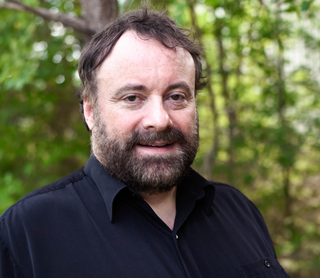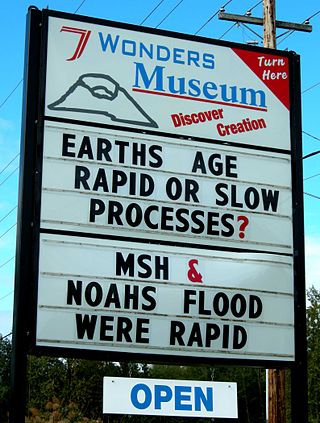
Creationism is the religious belief that nature, and aspects such as the universe, Earth, life, and humans, originated with supernatural acts of divine creation. In its broadest sense, creationism includes a continuum of religious views, which vary in their acceptance or rejection of scientific explanations such as evolution that describe the origin and development of natural phenomena.

Creation science or scientific creationism is a pseudoscientific form of Young Earth creationism which claims to offer scientific arguments for certain literalist and inerrantist interpretations of the Bible. It is often presented without overt faith-based language, but instead relies on reinterpreting scientific results to argue that various myths in the Book of Genesis and other select biblical passages are scientifically valid. The most commonly advanced ideas of creation science include special creation based on the Genesis creation narrative and flood geology based on the Genesis flood narrative. Creationists also claim they can disprove or reexplain a variety of scientific facts, theories and paradigms of geology, cosmology, biological evolution, archaeology, history, and linguistics using creation science. Creation science was foundational to intelligent design.

Young Earth creationism (YEC) is a form of creationism which holds as a central tenet that the Earth and its lifeforms were created by supernatural acts of the Abrahamic God between about 6,000 and 10,000 years ago. In its most widespread version, YEC is based on the religious belief in the inerrancy of certain literal interpretations of the Book of Genesis. Its primary adherents are Christians and Jews who believe that God created the Earth in six literal days.

Old Earth Creationism (OEC) is an umbrella of theological views encompassing certain varieties of creationism which may or can include day-age creationism, gap creationism, progressive creationism, and sometimes theistic evolution.

Day-age creationism, a type of old Earth creationism, is an interpretation of the creation accounts in Genesis. It holds that the six days referred to in the Genesis account of creation are not literal 24-hour days, but are much longer periods. The Genesis account is then reconciled with the age of the Earth. Proponents of the day-age theory can be found among both theistic evolutionists, who accept the scientific consensus on evolution, and progressive creationists, who reject it. The theories are said to be built on the understanding that the Hebrew word yom is also used to refer to a time period, with a beginning and an end and not necessarily that of a 24-hour day.

Flood geology is a pseudoscientific attempt to interpret and reconcile geological features of the Earth in accordance with a literal belief in the Genesis flood narrative, the flood myth in the Hebrew Bible. In the early 19th century, diluvial geologists hypothesized that specific surface features provided evidence of a worldwide flood which had followed earlier geological eras; after further investigation they agreed that these features resulted from local floods or from glaciers. In the 20th century, young-Earth creationists revived flood geology as an overarching concept in their opposition to evolution, assuming a recent six-day Creation and cataclysmic geological changes during the biblical flood, and incorporating creationist explanations of the sequences of rock strata.

Answers in Genesis (AiG) is an American fundamentalist Christian apologetics parachurch organization. It advocates young Earth creationism on the basis of its literal, historical-grammatical interpretation of the Book of Genesis and the Bible as a whole. Out of belief in biblical inerrancy, it rejects the results of scientific investigations that contradict their view of the Genesis creation narrative and instead supports pseudoscientific creation science. The organization sees evolution as incompatible with the Bible and believes anything other than the young Earth view is a compromise on the principle of biblical inerrancy.

Petroglyph National Monument stretches 17 miles (27 km) along Albuquerque, New Mexico's West Mesa, a volcanic basalt escarpment that dominates the city's western horizon. Authorized June 27, 1990, the 7,236 acres (2,928 ha) monument is cooperatively managed by the National Park Service and the City of Albuquerque. The western boundary of the monument features a chain of dormant fissure volcanoes. Beginning in the northwest corner, Butte volcano is followed to its south by Bond, Vulcan, Black and JA volcanoes.

Progressive creationism is the religious belief that God created new forms of life gradually over a period of hundreds of millions of years. As a form of old Earth creationism, it accepts mainstream geological and cosmological estimates for the age of the Earth, some tenets of biology such as microevolution as well as archaeology to make its case. In this view creation occurred in rapid bursts in which all "kinds" of plants and animals appear in stages lasting millions of years. The bursts are followed by periods of stasis or equilibrium to accommodate new arrivals. These bursts represent instances of God creating new types of organisms by divine intervention. As viewed from the archaeological record, progressive creationism holds that "species do not gradually appear by the steady transformation of its ancestors; [but] appear all at once and "fully formed."

Recurring cultural, political, and theological rejection of evolution by religious groups exists regarding the origins of the Earth, of humanity, and of other life. In accordance with creationism, species were once widely believed to be fixed products of divine creation, but since the mid-19th century, evolution by natural selection has been established by the scientific community as an empirical scientific fact.

The history of creationism relates to the history of thought based on the premise that the natural universe had a beginning, and came into being supernaturally. The term creationism in its broad sense covers a wide range of views and interpretations, and was not in common use before the late 19th century. Throughout recorded history, many people have viewed the universe as a created entity. Many ancient historical accounts from around the world refer to or imply a creation of the earth and universe. Although specific historical understandings of creationism have used varying degrees of empirical, spiritual and/or philosophical investigations, they are all based on the view that the universe was created. The Genesis creation narrative has provided a basic framework for Jewish and Christian epistemological understandings of how the universe came into being – through the divine intervention of the god, Yahweh. Historically, literal interpretations of this narrative were more dominant than allegorical ones.

The Institute for Creation Research (ICR) is a creationist apologetics institute in Dallas, Texas, that specializes in media promotion of pseudoscientific creation science and interpretation of the Genesis creation narrative as a historical event. The ICR adopts the Bible as an inerrant and literal documentary of scientific and historical fact as well as religious and moral truths, and espouses a Young Earth creationist worldview. It rejects evolutionary biology, which it views as a corrupting moral and social influence and threat to religious belief. The ICR was formed by Henry M. Morris in 1972 following an organizational split with the Creation Science Research Center (CSRC).

Henry Madison Morris was an American young Earth creationist, Christian apologist and engineer. He was one of the founders of the Creation Research Society and the Institute for Creation Research. He is considered by many to be "the father of modern creation science". He coauthored The Genesis Flood with John C. Whitcomb in 1961.

Jonathan David Sarfati is a young Earth creationist who writes articles for Creation Ministries International (CMI), a non-profit Christian apologetics ministry. Sarfati has a PhD in chemistry, and was New Zealand national chess champion in 1987 and 1988.

In creationism, a religious view based on a literal reading of the Book of Genesis and other biblical texts, created kinds are purported to be the original forms of life as they were created by God. They are also referred to in creationist literature as kinds, original kinds, Genesis kinds, and baramins.
Public Employees for Environmental Responsibility (PEER) is a 501(c)(3) non-profit, environmental protection organization of local, state, and national government natural resource and environmental professionals. PEER serves as a resource to potential government whistleblowers, allowing them to anonymously expose environmental wrongdoings and assisting them in redressing agency retaliation.
Leonard Brand is an American biologist, paleontologist, and Seventh-day Adventist creationist. He is a professor and past chair of Loma Linda University Department of Earth and Biological Sciences. Brand's most widely debated research was regarding fossil tracks at the Grand Canyon.
Andrew A. Snelling is a young-Earth creationist geologist who works for Answers in Genesis.

The Mount St. Helens Creation Information Center, previously Seven Wonders Creation Museum and Seven Wonders Museum of Mount St. Helens, is a ministry, museum, and bookstore dedicated to promoting young Earth creationism. The museum is located off of I-5 at Castle Rock, Washington on Front Street near Mount St. Helens, United States. Admission is free but donations are accepted, and often accompanied by a guided tour of volcano sights.

The ICR Discovery Center for Science & Earth History is a creationist museum in Dallas, Texas. Owned and operated by the Institute for Creation Research, the museum opened on September 2, 2019, with 1,600 people visiting on its first day.










